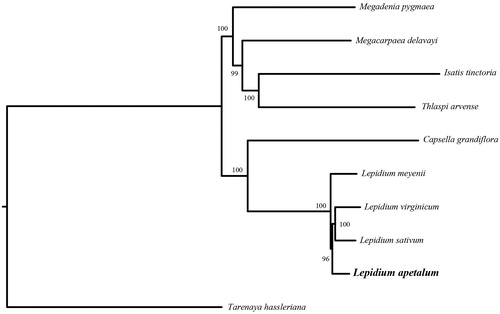Abstract
Lepidium apetalum is a traditional Chinese medicine. The complete chloroplast genome sequence is 154,680 bp in length, with one large single-copy region of 83,787 bp, one small single-copy region of 18,013 bp, and two inverted repeat (IR) regions of 26,440 bp. It contains 128 genes, including 83 protein-coding genes, eight ribosomal RNAs, and 37 transfer RNAs. Phylogenetic tree shows that this species is sister to L. sativum and L. virginicum.
Lepidium, a genus, belongs to the Brassicaceae family, contains approximately 16 species in China (Zhou et al. Citation2001), which indicates that especially the seeds were esteemed for their medicinal properties. The seeds of Lepidium apetalum are aperient, diuretic, tonic, demulcent, carminative, galatogogue, and emmenagogue (Bansal et al. Citation2012). However, there are very few studies on L. apetalum, which greatly limit the development and utilization of L. apetalum. So far, the chloroplast genome of L. apetalum has not been reported. In this study, we assembled the complete chloroplast genome of L. apetalum, hoping to lay a foundation for further research.
Fresh leaves of L. apetalum were collected from Nanhuashan mountain (Zhongwei, Ningxia, China; coordinates: 105°38′E, 36°21′N) and dried with silica gel. The voucher specimen was stored in Sichuan University Herbarium with the accession number of QTPLJQ13383021. Total genomic DNA was extracted with a modified CTAB method (Doyle and Doyle Citation1987). First, we obtained 10 million high quality pair-end reads for L. apetalum, and after removing the adapters, the remained reads were used to assemble the complete chloroplast genome by NOVOPlasty (Dierckxsens et al. Citation2017). The complete chloroplasts genome sequence of L. sativum was used as a reference. Plann v1.1 (Huang and Cronk Citation2015) and Geneious v11.0.3 (Kearse et al. Citation2012) were used to annotate the chloroplasts genome and correct the annotation.
The total plastome length of L. apetalum (MT588298) is 154,680 bp, exhibits a typical quadripartite structural organization, consisting of a large single-copy (LSC) region of 83,787 bp, two inverted repeat (IR) regions of 26,440 bp and a small single-copy (SSC) region of 18,013 bp. The cp genome contains 128 complete genes, including 83 protein-coding genes (83 PCGs), eight ribosomal RNA genes (four rRNAs), and 37 tRNA genes (37 tRNAs). Most genes occur in a single copy, while 16 genes occur in double, including four rRNAs, seven tRNAs (trnA-UGC, trnI-CAU, trnI-GAU, trnL-CAA, trnN-GUU, trnR-ACG, and trnV-GAC), and five PCGs (rps7, rpl2, rpl23, ndhB, and ycf2). The overall AT content of cp DNA is 63.6%, and the corresponding values of the LSC, SSC, and IR regions are 65.8%, 71.0%, and 57.0%.
In order to further clarify the phylogenetic position of L. apetalum, plastome of nine representative Brassicaceae species was obtained from NCBI to reconstruct the plastome phylogeny, with Tarenaya hassleriana as an outgroup. All the sequences were aligned using MAFFT v.7.313 (Katoh and Standley Citation2013) and maximum-likelihood phylogenetic analyses were conducted using RAxML v.8.2.11 (Stamatakis Citation2014). The phylogenetic tree shows that the species of Brassicaceae were divided into two subclades. All Lepidium species and Capsella grandiflora clustered together, while Remian species clustered in another clade, with L. apetalum clustered together with L. sativum and L. virginicum ().
Figure 1. Phylogenetic relationships of Brassicaceae species using whole chloroplast genome. GenBank accession numbers: Capsella grandiflora (NC_028517), Isatis tinctoria (NC_028415), Lepidium apetalum (MT588298), Lepidium meyenii (MT430983), Lepidium sativum (NC_047178), Lepidium virginicum (AP009374), Megadenia pygmaea (NC_034357), Megacarpaea delavayi (KX886349), Thlaspi arvense (NC_034362), and Tarenaya hassleriana (KX886354).

Disclosure statement
No potential conflict of interest was reported by the author(s).
Data availability statement
The data that support the findings of this study are openly available in GenBank of NCBI at https://www.ncbi.nlm.nih.gov, reference number MT588298.
Correction Statement
This article has been republished with minor changes. These changes do not impact the academic content of the article.
References
- Bansal D, Bhasin P, Yadav OP, Punia A. 2012. Assessment of genetic diversity in Lepidium sativum (Chandrasur) a medicinal herb used in folklore remedies in India using RAPD. J Genet Eng Biotechnol. 10(1):39–45.
- Dierckxsens N, Mardulyn P, Smits G. 2017. NOVOPlasty: de novo assembly of organelle genomes from whole genome data. Nucleic Acids Res. 45(4):e18
- Doyle JJ, Doyle JL. 1987. A rapid DNA isolation procedure for small quantities of fresh leaf tissue. Phytochem Bull. 19:11–15.
- Huang DI, Cronk Q. 2015. Plann: a command-line application for anno-tating plastome sequences. Appl Plant Sci. 3(8):1500026.
- Katoh K, Standley DM. 2013. MAFFT multiple sequence alignment software version 7: improvements in performance and usability. Mol Biol Evol. 30(4):772–780.
- Kearse M, Moir R, Wilson A, Stones-Havas S, Cheung M, Sturrock S, Buxton S, Cooper A, Markowitz S, Duran C, et al. 2012. Geneious basic: an integrated and extendable desktop software platform for the organization and analysis of sequence data. Bioinformatics. 28(12):1647–1649.
- Stamatakis A. 2014. RAxML version 8: a tool for phylogenetic analysis and post-analysis of large phylogenies. Bioinformatics. 30(9):1312–1313.
- Zhou TY, Lu LL, Yang G, Al-Shehbaz IA. 2001. Orychophragmus Bunge. In: Wu ZY, Raven PH, editors. Flora of China, Vol. 8. Beijing: Science Press; St. Louis: Missouri Botanical Garden Press. p. 29–31.
